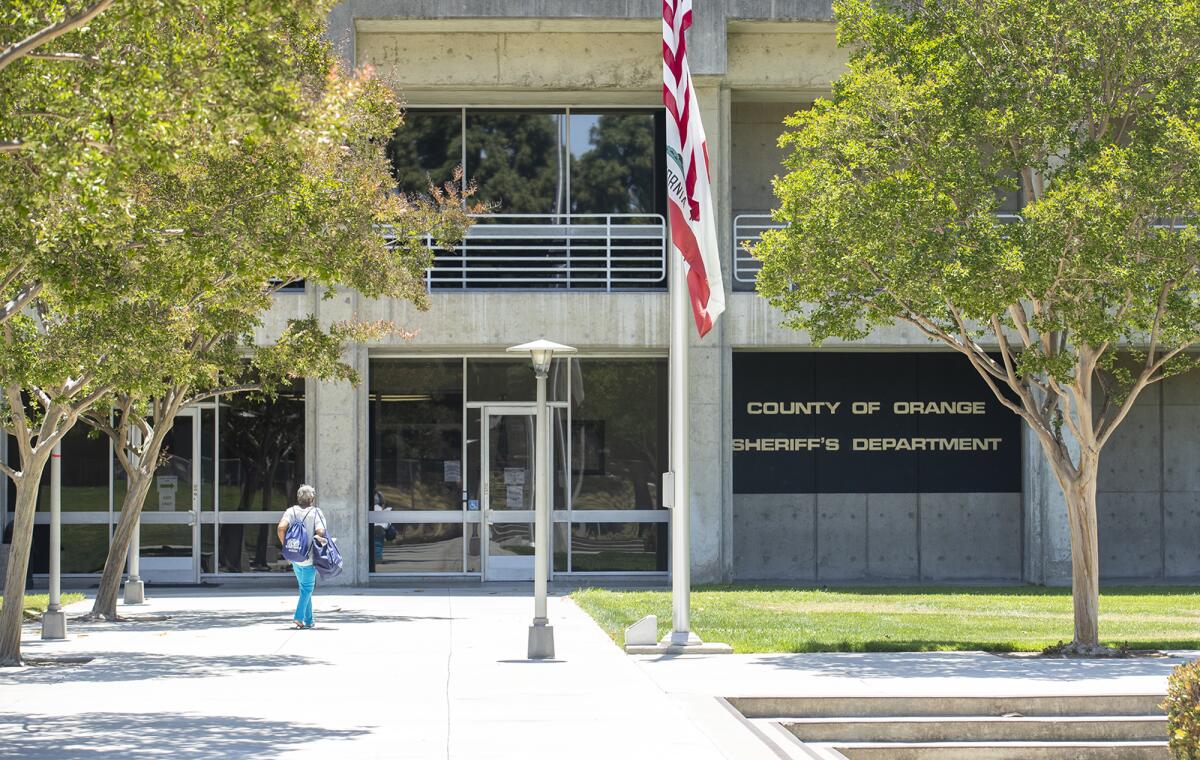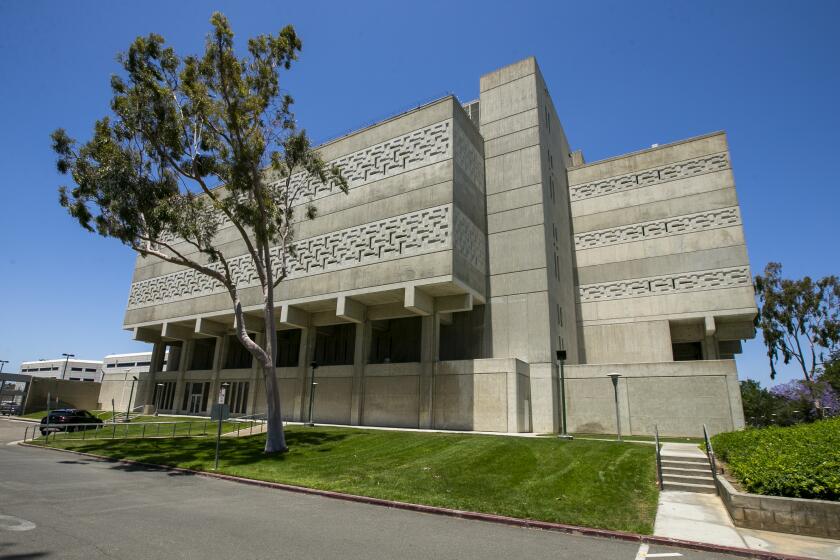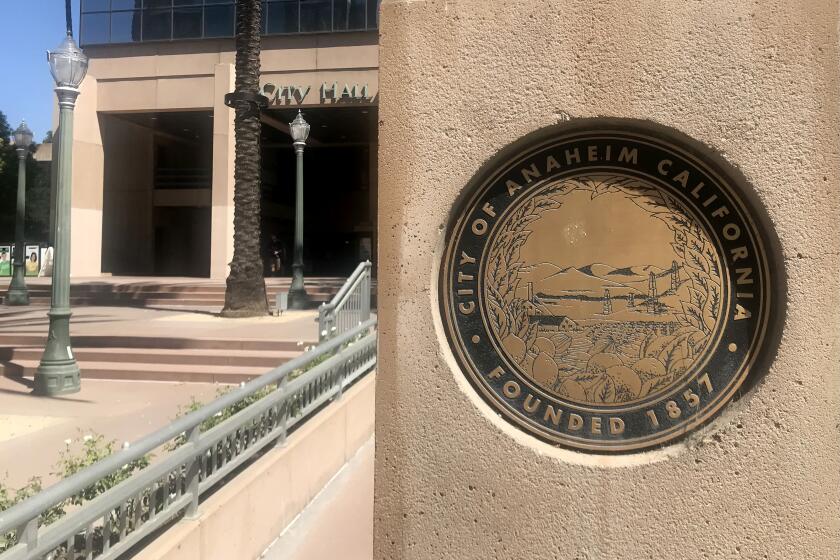O.C. Sheriff’s Department rolling out body camera program after years of consideration

Following in the footsteps of other Orange County law enforcement agencies, the Orange County Sheriff’s Department finally started rolling out body-worn cameras this week after years of consideration.
The move is meant to promote transparency and aid investigations.
“I think some of the most important aspects are that collection of evidence of course, but also just enhancing public trust and having that accountability for everybody that’s possibly involved in whatever incident that is being recorded,” Sgt. Matthew Timmins said.
Timmins said the body cams will be rolled out in phases from the north to south divisions. The first cameras were deployed this week in Yorba Linda. Eventually, 40 deputies will be using them in the city. The department is aiming to have all the cameras — slightly more than 1,000 — deployed by the end of next year. In late July, the county Board of Supervisors approved a $12.7-million contract for 1,051 body cameras and 335 in-car cameras.
Orange County Sheriff Don Barnes’ department has contracts with 13 cities, including Aliso Viejo, Dana Point, Laguna Hills, Laguna Niguel, Laguna Woods, Lake Forest, Mission Viejo, Rancho Santa Margarita, San Clemente, San Juan Capistrano, Stanton, Villa Park and Yorba Linda.
Undersheriff Jeff Hallock said the department has been considering body cameras for a number of years.
In recent years, Huntington Beach, Anaheim, Santa Ana and Fullerton adopted body cams. Irvine and Costa Mesa greenlighted programs last year.
About 47% of small- and medium-sized law enforcement agencies use body-worn cameras in the U.S., according to a 2018 report from the Bureau of Justice Statistics. About 80% of large police agencies, similar in size to that of Los Angeles or Boston public safety agencies, have body-worn camera programs.
“We were very slow and deliberate about reviewing the technology and making sure that we chose the right company, the right contract to implement the program,” Hallock said.

Michael Gennaco, who has provided independent oversight of law enforcement agencies for a number of years, said it’s “about time” that the Sheriff’s Department implemented body cams.
“Many of the leading agencies in that county have had full activation and deployment for six years or longer,” said Gennaco, who is founder of the Office of Investigative Review Group, which has been contracted with the city of Anaheim to provide investigations and reports on the police department since 2007.
Gennaco believes body cams will help encourage transparency.
“In my experience, I think that the deployment of body-worn cameras has been really a game changer with regard to the ability to have an unvarnished assessment of what has transpired,” Gennaco said. “You don’t always get that, sometimes the cameras get dislodged, sometimes they get blocked from view because of officer’s being tactically engaged. More frequently they do capture at least some of what occurred if they are effectively deployed, consistent with the department’s expectation, so I think it’s long overdue.”
But Jennifer Rojas, policy advocate and organizer with the American Civil Liberties Union of Southern California, said that body cams have been present in the county for a number of years, yet there still isn’t accountability from law enforcement.
“I think at this point we have to question the extent that body cameras can result in accountability,” Rojas said. “... Body cameras were introduced as a policy reform to try to prevent people being killed by police and to respond to the demand by community members to prevent people being killed by police. And yet, we have not seen body-worn cameras result in that measure of accountability.”
She also said that body camera footage has been used to “exonerate” law enforcement officers and “prosecute” victims of police violence. She specifically referenced the killing of Hector Hernandez, a Fullerton resident who was shot by a police officer in his frontyard. A coalition of about 20 organizations has been working to hold the officer accountable, though Dist. Atty. Todd Spitzer’s office cleared him in August.
Oscar Daniel Moriel, who had pled guilty to the charge of felon in possession of a firearm, was found dead of a self-inflicted gunshot wound in Huntington Beach in September.
The Fullerton Police Department released body camera footage of the Hernandez shooting online. It was accompanied by commentary from the department.
“The department released a highly editorialized video of their body-worn camera footage,” Rojas said. “It’s unfortunate because it builds a narrative that really prosecutes victims of police violence, just as in the case of Hector Hernandez.”
Hallock said the department decided a few months ago to move forward with the company Axon. The department held a pilot program with the company’s cameras in 2018.
“Based on the size of their company, the speed they could get us equipment, and infrastructure that surrounds Axon, we just felt like it was the best choice for our organization,” Hallock said.
Hallock said the company also uses the platform evidence.com, which is the same platform used by the Orange County district attorney’s office to move video back and forth between the agency and law enforcement agencies while prosecuting cases.
Axon body cams will also work in tandem with in-car cameras, which the department has been using for years.
Hallock said the plan is to put body cams on anybody who is “public facing,” including deputies, investigators, special officers, as well as sheriff’s employees at John Wayne Airport, and county and court buildings. Hallock said the department will also have a pool of cameras for emergency operations, such as “riot control.”
Timmins said deputies will need to turn on their cameras when responding to a scene. Once they start recording, the camera records the first minute before it was activated, though there won’t be any audio during that period. Timmins said after the deputies are finished with their shift, they will put the camera on a docking station to upload footage and charge the camera.
Deputies will receive a three-hour training session on the body cams prior to using them.

Orange County sheriff’s policy states that: “A member may activate the system any time the member believes it would be appropriate and valuable to document an investigation, incident or contact. In general, [body worn and in-car camera] activation shall begin prior to arriving at a call or initiating enforcement action and shall terminate once the member has cleared their self from the call or the contact and/or the incident has concluded.”
The policy provides a number of examples of when the cameras are required to be activated, including all calls for service, detentions and arrests, DUI observations, searches, witness and victim interviews, prisoner transportation, crowd management and contact with the public that may become confrontational.
The policy also provides a list of exceptions to the required activation of body cams, including if a recording would interfere with their ability to investigate and if a deputy isn’t able to turn on the cameras “prior to initiating enforcement or investigative activities due to officer safety, public safety or any other critical circumstance.” There are a few other exceptions listed in the policy.
Sheriff’s spokesperson Jaimee Blashaw said that the department’s Media Analysis Bureau will conduct periodic audits to ensure proper compliance, which includes camera activation, deactivation, video tagging and categorization. Other departments in Southern California have not fared well in maintaining compliance from their officers.
According to a review by the department’s inspector general from earlier this year, 22% of Los Angeles Police Department officers failed to promptly activate their body cams in use of force incidents. Also, a San Diego police oversight commission said in a memo in late June that officers aren’t activating their cameras when they need to.
“It’s a big concern if law enforcement agencies have body cameras and they’re not activating the body cameras when law enforcement officers are engaging with members of the public,” Rojas said.
Gennaco said that the Orange County Sheriff’s Department’s policy needs to provide effective guidance to deputies to ensure that they activate the cameras when they are supposed to. Gennaco said that auditing is important to ensure that law enforcement personnel are activating their cameras.
“Most sound policies will instruct officers that whenever there is an expected encounter between themselves and the public, they’re supposed to activate the cameras,” Gennaco said. “What we’ll often see is officers will be riding to a hot call and they’ll get to the call and immediately jump out and go tactical and then there’s no activation.
“There shouldn’t be much discretion there, it should be if you’re going to a call that’s hot, or encounter a citizen on a stop, either a vehicle or pedestrian stop, you’ve got to turn that camera on.”
Gennaco said deputies should be activating their cameras once they turn on their lights and siren. Blashaw said that once the body cam system is fully implemented, the in-car and body cameras will automatically activate when the lights and siren are turned on in an Orange County sheriff’s vehicle. Blashaw said deputies are being trained to activate their cameras when turning on their lights and sirens as the department rolls out the program.
All the latest on Orange County from Orange County.
Get our free TimesOC newsletter.
You may occasionally receive promotional content from the Daily Pilot.





